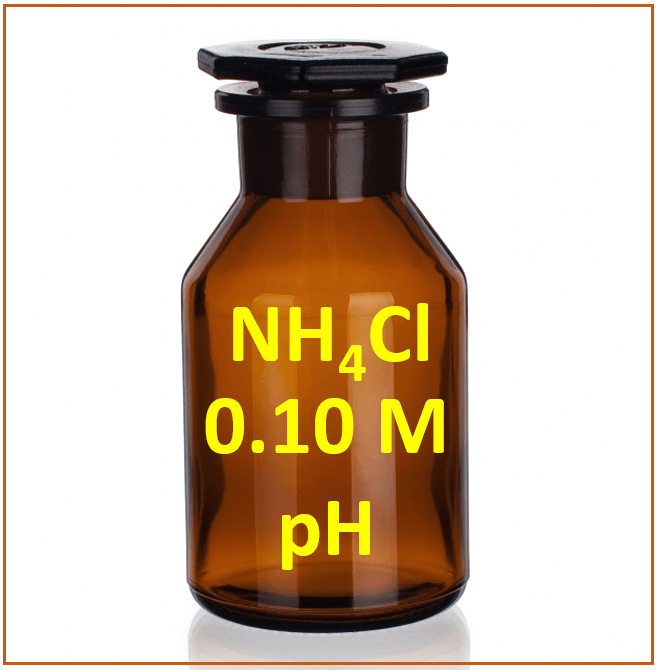Ammonium chloride (NH4Cl) is the salt of a weak base ammonia (NH3) and a strong acid HCl, so it yields an acidic solution.
NH3 + HCl → NH4Cl
So, let’s follow what we have discussed earlier and see why it produces an acidic solution.
Dissociate the salt to identify the weak component ion that will react with water:
NH4Cl → NH4+ + Cl–
NH4+ is the ion with a weaker component (NH3), so it is going to react with water producing hydronium ion which makes the solution acidic:
NH4+(aq) + H2O(l) → NH3(aq) + H3O+(aq) (acidic)
The next part is to determine the concentration of H3O+ ions in order to calculate the pH.
We are given the Kb, which measures the base strength, and it is based on the reaction of ammonia itself with water:
NH3(aq) + H2O(aq) ⇆ NH4+(aq) + OH–(aq)
This equation does not contain H+/H3O+ ions, and we do not know the concentration of ammonia, therefore, we need to determine the Ka.
Ka and Kb can be calculated from one another using the relationship:
Ka · Kb = Kw = 10-14
Rearranging this, we get an expression for Ka:
\[{K_{\rm{a}}}\; = {\mkern 1mu} \frac{{{K_{\rm{w}}}}}{{{K_{\rm{b}}}}}\; = \;\frac{{{\rm{1}}{{\rm{0}}^{{\rm{ – 14}}}}}}{{{\rm{1}}.{\rm{76}}\; \times \;{\rm{1}}{{\rm{0}}^{{\rm{ – 5}}}}}}\; = \;{\rm{5}}.{\rm{68}} \times {\rm{1}}{{\rm{0}}^{{\rm{ – 10}}}}\]
Once we know the Ka, it is the same procedure as we do when calculating the pH of a weak acid.
We assign x mol/l for ionization and set up an ICE table to determine the [H3O+]:
NH4+(aq) + H2O(l) → NH3(aq) + H3O+(aq) (acidic)
|
|
[NH4+] |
[NH3] |
[H3O+] |
|
Initial |
0.10 |
0 |
0 |
|
Change |
-x |
+x |
+x |
|
Equil |
0.10 – x |
x |
x |
Next, write the expression for Ka using the equilibrium concentrations in the ICE table:
\[{K_{\rm{a}}}\; = {\mkern 1mu} \frac{{[{\rm{N}}{{\rm{H}}_{\rm{3}}}][{{\rm{H}}_{\rm{3}}}{{\rm{O}}^{\rm{ + }}}]}}{{[{\rm{N}}{{\rm{H}}_{\rm{4}}}^{\rm{ + }}]}}\; = \;\frac{{{{\rm{x}}^{\rm{2}}}}}{{{\rm{0}}.{\rm{10}}\;{\rm{ – }}\;{\rm{x}}}}\; \approx \;\frac{{{{\rm{x}}^{\rm{2}}}}}{{{\rm{0}}.{\rm{10}}}} = \;{\rm{5}}.{\rm{68}}\, \times \,{\rm{1}}{{\rm{0}}^{{\rm{ – 10}}}}\]
Therefore, x = 7.54 x 10–6
Check if the approximation was valid:
\[\% {\mkern 1mu} = \;\frac{{7.54{\mkern 1mu} \times \;{{10}^{ – 6}}}}{{0.10}}\; \times \;100\% \; = \;0.0075\% \]
The percentage of hydrolysis is less than 5%, and therefore, the approximation is valid.
The concentration of H3O+ ions is 7.54 x 10-6 M, so the pH is:
pH = -log 7.54 x 10-6 = 5.12
This indicates an acidic solution which is what we expected to have for the solution of NH4Cl.
Check Also
- Definitions of Acids and Bases
- Acid-Base Reactions
- Acid-Base Titrations
- Conjugate Acid and Conjugate Base
- Autoionization of Water and Kw
- The pH and Acidity
- Acid Strength, Ka, and pKa
- Base Strength, Kb, and pKb
- Ka, pKa, Kb, and pKb Relationship
- The pH of a Strong Acid and Base
- pH + pOH = 14
- The pH of a Weak Acid
- The pH of a Weak Base
- The pH of Polyprotic Acids
- The acidity of a Salt Solution
- The pH of a Salt Solution
- The pH of Salts With Acidic Cations and Basic Anions
- pH Practice Problems
- Acids and Bases Practice Problems
Acids and Bases Quiz

